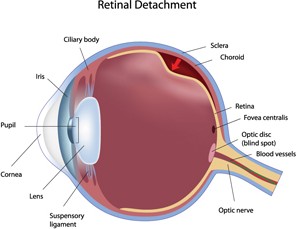When light enters your eye, the retina changes the light into nerve signals. It sends these signals along the optic nerve to the brain. Without a retina, your eye cannot communicate with the brain making vision impossible. Great Lakes Eye Institute specializes in the medical and surgical care of retina related conditions and diseases. Our skilled surgeons have met the most stringent requirements of medical training, internship, residency, and vitreoretinal fellowship and are board certified by the American Board of Ophthalmology. Their credentials include numerous professional achievements. – Experience you can count on.
The GLEI Surgery Center provides the use of the most advanced technology and we progressively analyze emerging technology and innovative techniques to benefit our patients.
Vision Clouding, Floaters, and Flashes?
One of the most common conditions of the retina is retinal tearing or detachment. The middle of our eye is filled with a clear gel called vitreous that is attached to the retina. Sometimes tiny clumps of gel or cells that form inside the vitreous will cast shadows on the retina. You may experience seeing small dots, specks, or clouds commonly referred to as “floaters” moving in your field of vision.
As part of the aging process, at some point in our life, the vitreous often shrinks and separates from the back of the eye. When this happens, you may notice symptoms of flashing lights, lightning streaks or the sensation of seeing stars. These are called flashes. Because the retina is an extremely thin and fragile structure, if the vitreous separation produces sufficient force, it can cause a break or tear in the retinal surface.
When the retina tears, it usually does so in the far corners of the retina and may not compromise vision. However, retinal breaks or tears can over time (from days to years) begin to accumulate fluid underneath them, which can gradually cause the retina to separate from the wall of the eye. This is called retinal detachment. – A serious condition that almost always causes blindness unless treated by detached retina surgery.
People who have symptoms of vitreous separation should be evaluated for the presence of retinal tears. If retinal tears are found, they are usually sealed using laser or cryotherapy to prevent retinal detachment from occurring.
If retinal detachment occurs, it is important to have the condition repaired before the central part of the retina (macula) is itself involved in the retinal detachment. Once the macula is involved, the prognosis for good vision, even after successful repair, is lessened. Methods of repair for retinal detachment include: Pneumatic retinopexy or Vitrectomy. The type of procedure we ultimately recommend depends on the characteristics of the retinal detachment.
Your Great Lakes Eye Institute ophthalmologist can diagnose a retinal tear, detachment, and many other disorders of the retina during a routine eye examination. That’s why it is so important to have regular exams.


